“Riding a Wheel” – Westside Cycling History
At the end of the nineteenth century, in the heyday of what historian Luthor Ingersoll (1851-1926) called “cycle fever,” it seemed that everybody was “riding a wheel” in West Los Angeles.
“During the rage of the cycling fever the annual road race on July Fourth was the leading event of the year to bicycle racers. On those days Santa Monica was crowded with dusty, sweating, red-faced youths, in the most abbreviated of clothes and with the most enthusiastic of yells, greeting each man as he pedaled into view. A bicycle path to Los Angeles was constructed, bicycle clubs and a club house flourished, and the Southern Pacific spent thousands of dollars on a bicycle race track and grand stand which was probably the poorest investment that the S. P. railway ever made, for almost before it was completed the bicycle craze died out as suddenly and as completely as the various spells of roller skating, which sweep over the country and vanish into space. The Athletic Park, as it was christened, was used for several years for ball games and sports of various kinds, but it has now become a thing of the past.” (Luthor Ingersoll, Century History, Santa Monica Bay Cities (1908) pp. 307-308.)

These members of the Los Angeles Wheelmen won fame as bicycle racers in the “gay nineties.” Standing, left to right, Tom McAller, who was registrar of voters; Walter Tyler, realty man; Philip Kitchen, banker. Foreground, left to right, Billy Jenkins, rancher, and Emil Ulbrecht [sic]. Jenkins is the only survivor. Ulbrecht was killed by a shark in Hawaii 20 years ago. The photo belongs to Tracy Q. Hall, banker, who was one of the wheelmen.
Los Angeles Herald (April 25, 1934).
“Wheelmen of the Past Century” reunions
In 1924, racers from those halcyon days began to have reunions as the Wheelmen of the Past Century. The elder wheelmen met until at least 1953. Since their cycle fever days, several had gained fame in automobile racing while others became prominent civic leaders.
Pictured below, in 1953, are famed auto racing champion Ralph De Palma (1882-1956), Los Angeles auto pioneer Ralph Hamlin (1880-1974), and USC coach Dean Cromwell (1879-1962) with Eugene W. Biscailuz (1883-1969), who had organized the California Highway Patrol and later became the 27th Sheriff of Los Angeles County (1932-1958). (Photo courtesy of USC Libraries; left to right: Ralph de Palma, Frank Pearne, Ralph Hamlin*, Floyd Clymer, Dean Cromwell, Earl Le Moyne, Sheriff Eugene W. Biscailuz [*the library incorrectly lists Hamlin second from left, so others may be listed wrong as well].)
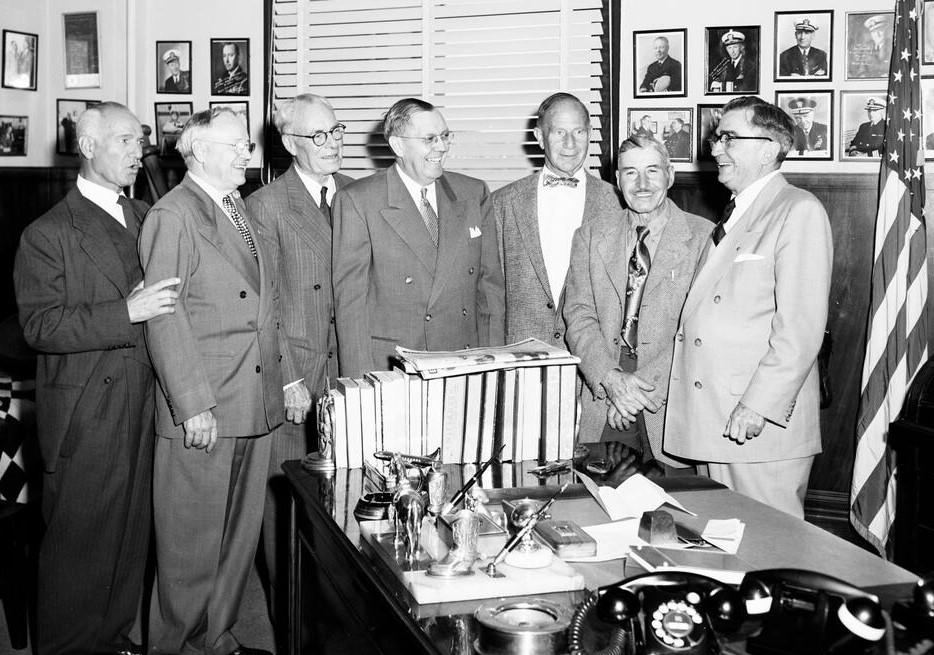
Though Ralph Hamlin earned his fame racing and selling cars, the LA Times obituary reported, “his fondest accomplishment, he once told an interviewer, was winning a 1900 bicycle race from East Los Angeles to Corona and back. He covered the route in 6 hours and 11 minutes.” Indeed, the April 30, 1900, LA Herald reported, “The sixth annual century run of the East Side Cycling club was made yesterday. Ralph Hamlin won by a quarter of a minute over B. A. Holmes. Hamlin’s time was 6 hours and 11 minutes. This lowers the former record by 36 minutes.“
Cycling Champion Hans Ohrt carries the cycling torch forward
Though he had not raced in the Nineteenth Century, 1915’s national amateur cycling champion, Hans Ohrt (1895-1960), attended (at least) the 1934 and 1948 Wheelmen of the Past Century reunions. As shown in the picture below, Ohrt and 1946 national amateur champion Don Hester – along with artist Norman Rockwell – were feted at the 1948 affair. Han Ohrt became Los Angeles’ leading cycling proponent.
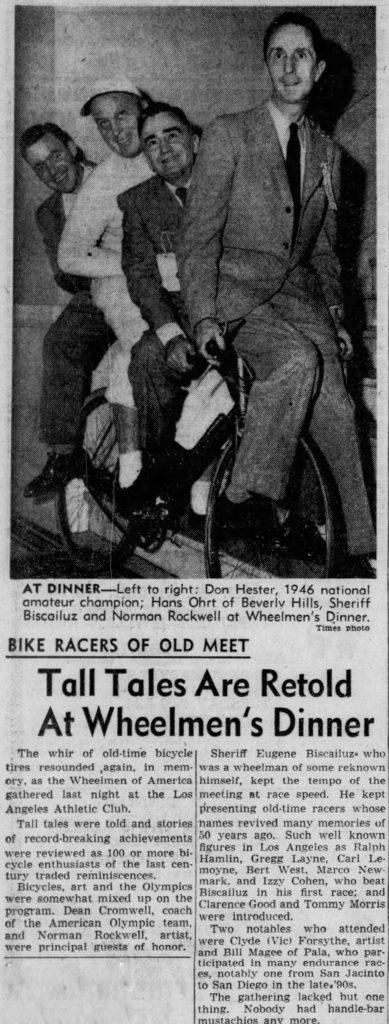
Hans Ohrt meant bicycling in Los Angeles in the mid-Twentieth Century. He served as a member of the 1932 Los Angeles Olympic Games cycling committee. He opened Hans Ohrt Lightweight Bicycles at the corner of Little Santa Monica Boulevard and Camden Drive in Beverly Hills in 1937. (LA Times 12/30/76.)

The brass plaque shown above had hung over the outside main entrance at Hans Ohrt’s Beverly Hills shop: “MY NOTION IS THAT MANKIND WOULD BE BETTER MORTALS IF THEY ALL RODE BICYCLES.” It was later displayed in the Helen’s Cycles Santa Monica store.
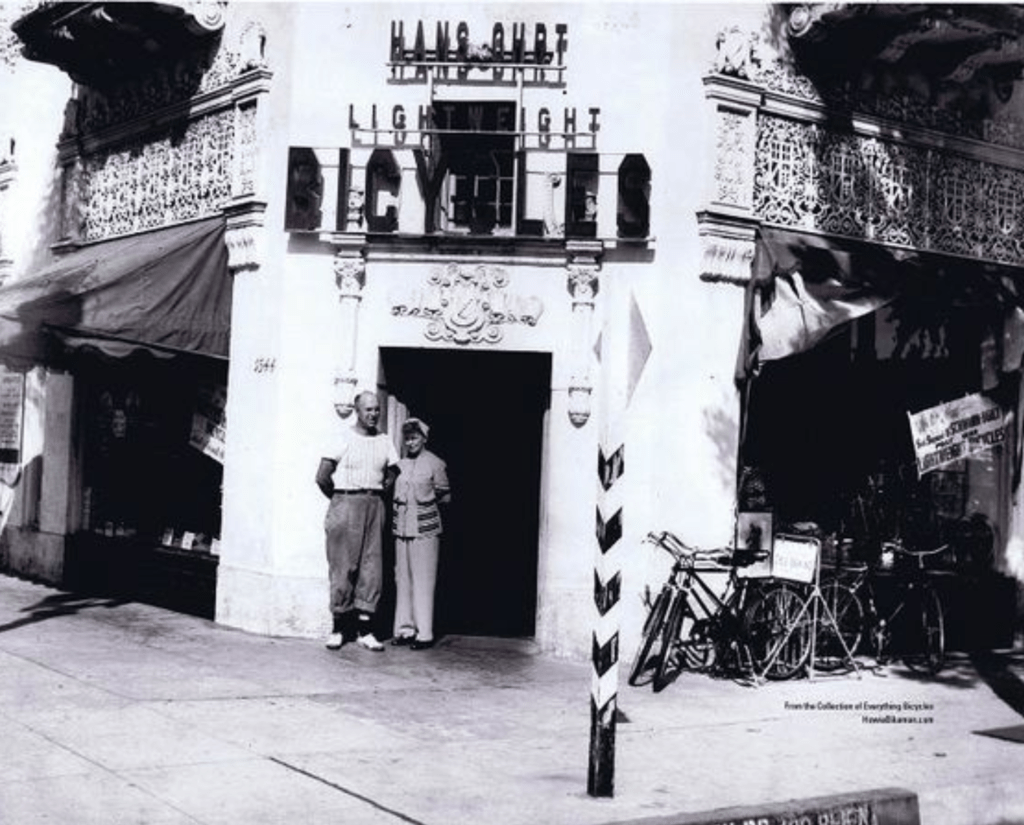
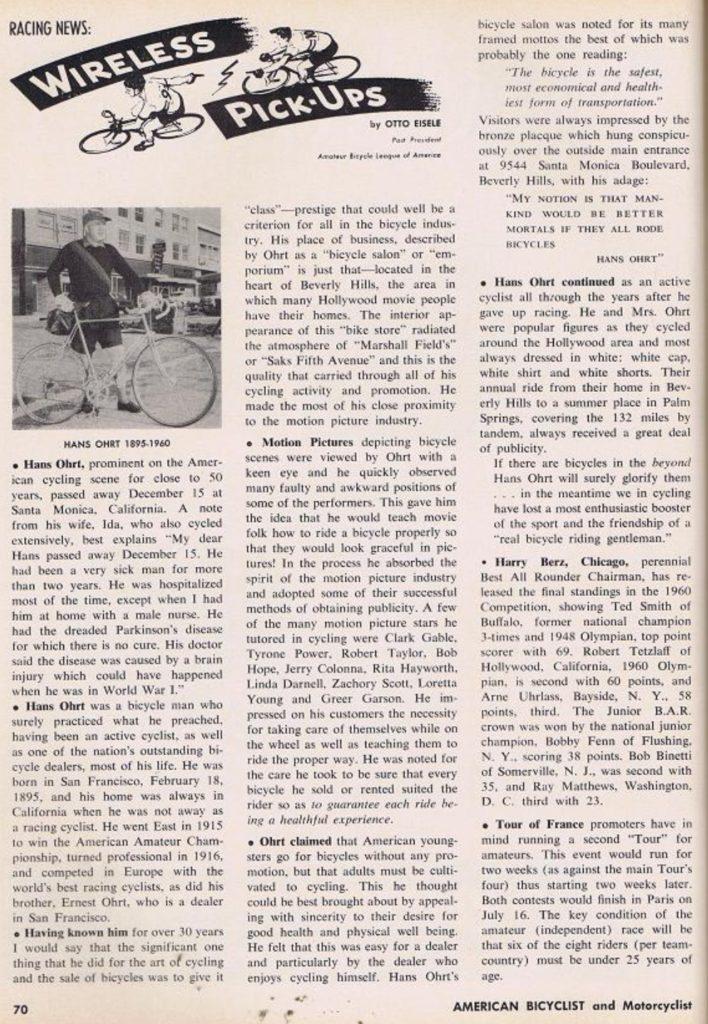
In the above obituary, American Bicyclist and Motorcyclist Magazine recounted of Ohrt that “motion picture stars he tutored in cycling were Clark Gable, Tyrone Power, Robert Taylor, Bob Hope, Jerry Colonna, Rita Hayworth, Linda Darnell, Zachary Scott, Loretta Young and Greer Carson.” The Los Angeles Times covered Hans Ohrt in the society page and quoted him often on sports.
Ohrt’s niece Connie (Ohrt) Hearst and her husband Leonard Hearst, an avid cyclist himself, took over the business in 1950, owning and managing Hans Ohrt Lightweight Bicycles stores in Beverly Hills, Westwood and Los Angeles until 1984.
Helen’s Cycles (est’d 1936) took over the Westwood location at 1071 Gayley Avenue, which operated there from 1977 until the Hans Ohrt Lightweight Bicycles business was dissolved in 1987.
Both the Ohrt and Helen’s shops sponsored a now-prominent cycling club, Velo Club La Grange, founded in 1969 by Frenchman Raymond Fouquet (1920-2013).
Torch picked up by Alex Baum and Raymond Fouquet
French émigrés, and later friends, Alex Baum (1922-2015) and Raymond Fouquet (1920-2013) played leading roles in cycling in Los Angeles in the Twentieth Century. Fouquet is memorialized by Raymond Fouquet Square at Westwood Boulevard and La Grange Avenue. Every Sunday, Raymond Fouquet Square is the starting point of the “Nichols Canyon Ride,” which Fouquet started from his nearby La Grange Restaurant in 1969.

Like Ohrt 50 years before, Alex Baum helped bring Olympic cycling to Los Angeles.
As part of the local organizing committee for the 1984 Olympics, Baum helped establish the Games’ first women’s bike racing events. They have since become a regular feature at the Summer Olympics. He also became a board member of the U.S. Cycling Federation – now known as USA Cycling, and was the first American appointed to the board of the Union Cycliste Internationale, a governing body for bicycling based in Aigle, Switzerland.
L. A. Times March 3, 2015
Baum also championed (among other projects) the Los Angeles River bike path. His advocacy was recognized with the 2002 Alex Baum Bicycle Bridge across Los Feliz Boulevard, rededicated to him in 2012. (Alex Baum 1922-2015 – Los Angeles City’s Stalwart Bicycling Advocate, Streetsblog LA 3/2/15.)
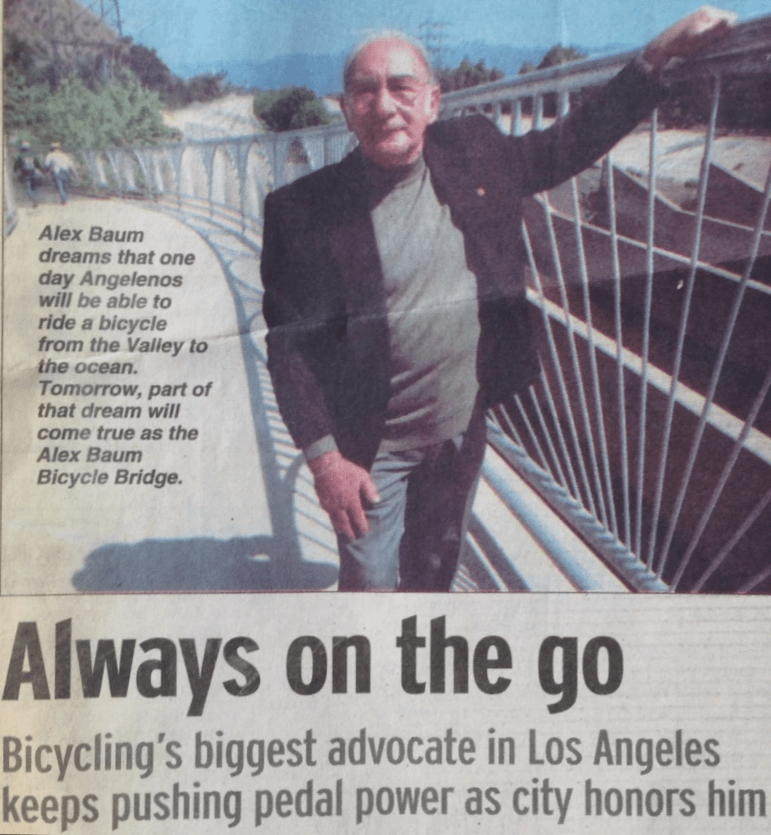
Bobier’s Bike Shop, Palms Cycle, & Bike Shop California
In the 1920s, Earl E. Bobier sold Buick and Star Car automobiles (“Tomorrow’s Car Today”) from Bobier Garage in Culver City. Starting around 1945, Mr. Bobier was selling Schwinn Bicycles (“GUARANTEED . . . As Long As You Own It”) from Bobier’s Bike Shop at 3770 Motor Avenue in Palms. (Incidentally, Palms is the Birthplace of BMX.) Bobier’s Bike Shop operated under that name until at least 1954.
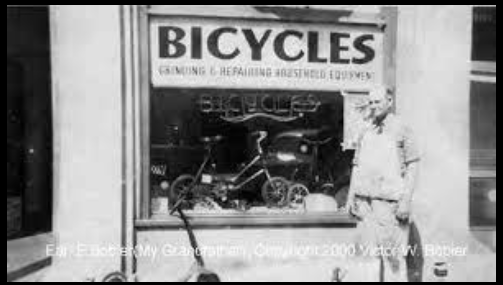
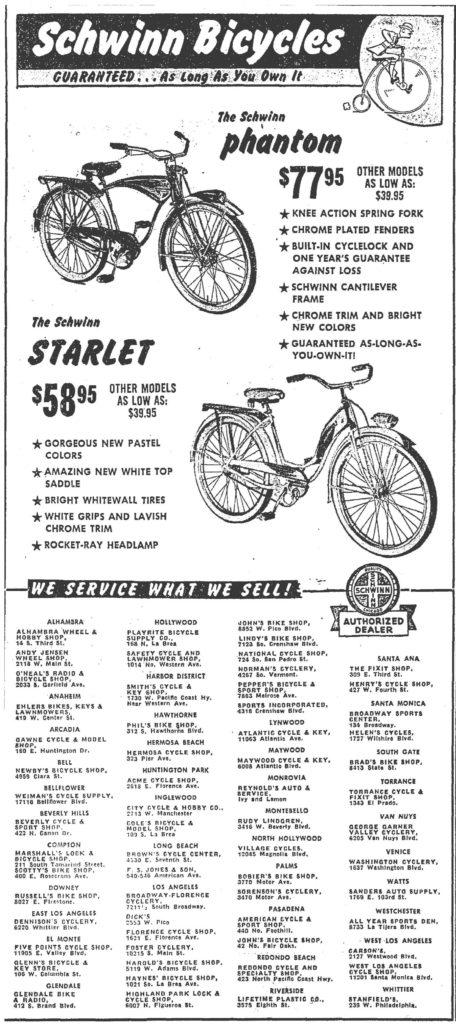
Lyle “Cap” Rancier’s family bought the Motor Avenue bicycle operation in 1964 and ran it through 2018 as Palms Cycle Shop, when it reopened under new ownership as The Bike Shop California. It was one of the oldest bike shops in the City of Los Angeles (maybe the oldest) when it was converted to a motor cycle shop in 2024.
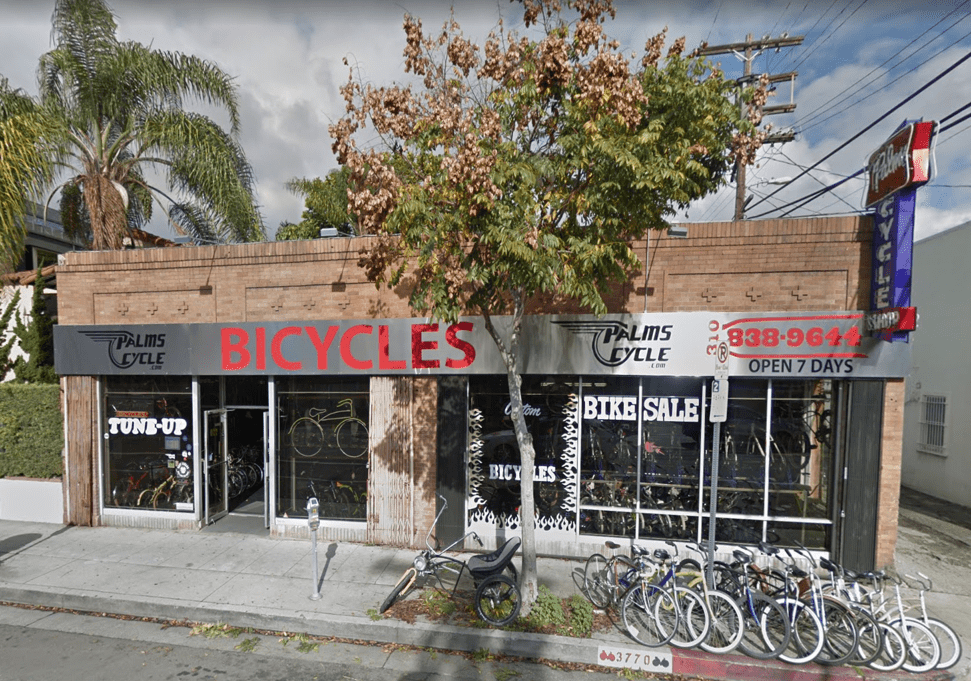
Glossary
Machine = bicycle
Wheel = bicycle (the illustration at the top was entitled “Riding a Wheel for Pleasure”)
Wheelman = bicyclist
Scorcher = speedy or reckless bicyclist
Scratch rider = a bicyclist without a handicap, i.e., an earlier start in a race. (Slower riders started minutes earlier so they had a chance to finish at the same time as the scratch riders.)